Can a $15 Box of Shorts Come Out on Top?
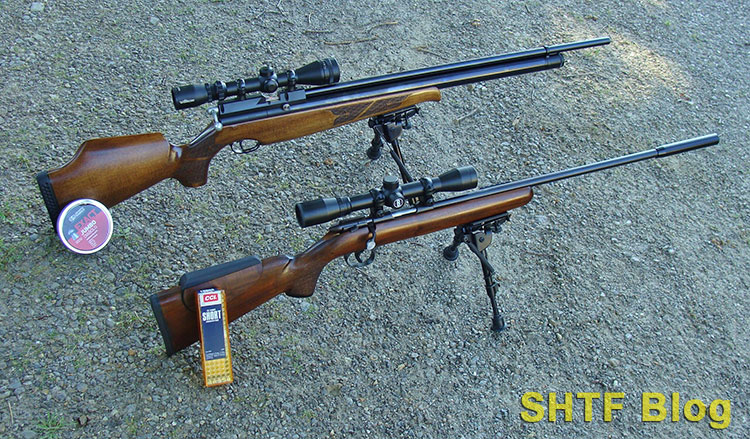
Gas and ammunition costs being high, I’ve spent more time on my backyard range lobbing pellets at longer distances through fast- stepping airguns. Airgun projectiles have, for the most part, remained available at fair prices, to include premium pellets ordered via specialty suppliers. And when the latter types are shot through the latest genre of higher-end air rifles, things can get interesting.
Hit the right combination and a remarkable degree of accuracy is possible at hundred yards – or even further, using aerodynamic airgun “slugs” that resemble bullets. So far, I’ve stuck with conventional diabolo pellets, shot to 100 yards through a tack-driving .22-caliber pre-charged pneumatic rifle. Unlike the multi-pump pellet guns that gave us exercise as kids, each successive shot from a PCP version doesn’t require a brisk workout.
Instead, a PCP gun is “pre-charged” via an external high-pressure air source: typically, a scuba tank, special airgun pump, or HPA compressor. Once pressurized, it’s just a matter of operating the action, pretty much like the bolt of a .22 rimfire. Those with rifle-length reservoirs will often yield 25 to 40 useful shots (or more), producing astonishing accuracy and a very quiet report. And being airguns, they can be used in spots where firearms would be off-limits. Still, for me at least, there will always be a place for a quiet .22 rimfire rifle.
“Short” Story
During a recent summer’s eve spent sniping small reactive metal targets to 100 yards, the pressure gauge on my airgun indicated it was finally quitting time. Leaving the rifle behind, I headed downrange with a can of spray paint to touch up the impacts – when I happened to spot a large porcupine in a prized apple tree near the far end.
It was either my orchard or the porky, so I made a beeline back up-range. The airgun, a .22-caliber Air Arms M-400 (now the 500-series), is tuned to launch 15.9-grain JSB pellets at 920 feet per second (fps) – performance that seems similar to some .22 rimfire loads.
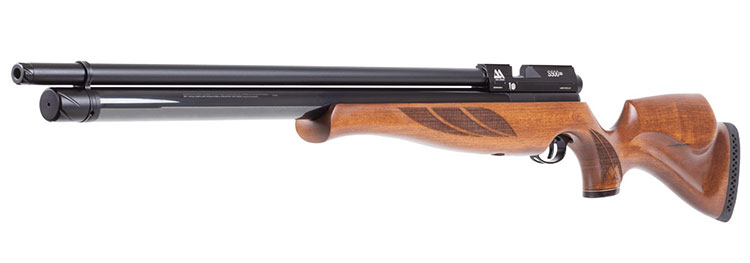
Air Arms S500XS Xtra PCP Air Rifle with regulator | Pyramyd Air

JSB Diabolo Exact Jumbo .22 Cal, 15.89 Grains, Domed, 500ct | Pyramyd Air
But rather than reach for the airgun, I headed toward the house after a basic single-shot bolt-action .22 rifle, and some Shorts. The aging Remington Model 510 was my go-to critter-control rifle prior to the acquisition of the AA M-400 but, nowadays, the latter handles most such chores with less worries about collateral damage.
However, it never did completely obsolete the trusty Remington .22 rifle. The reason boils down to projectile energy.
.22 Airgun vs Rimfire Power
According to airgun hyperbole, my PCP rifle qualifies as a “magnum.” Meanwhile, in firearms terms, the .22 Short (America’s oldest metallic cartridge) is considered anemic. Perhaps, but its 29-grain bullet is double the weight of many .22-calber pellets. Thus, at a similar muzzle velocity (MV) of 950 fps, the heavier bullet generates twice as much muzzle energy – “super magnum” by airgun standards! And the difference becomes apparent as animate target sizes increase.
For pest birds through pigeons, standard .22-caliber pellets with MVs of 800 – 900 fps are effective. They’re also safer than rimfire loads in farm settings that often involve rooftop shots near workers and livestock. The same projectiles will also handle gray squirrels with careful shooting. But larger species can be iffy. I’ve taken woodchucks via precisely delivered head shots, but a .22 rimfire is the more humane minimum.
And like groundhogs, porcupines run large – and tough! Thus, even with .22 LR hollow-points, head shots are the better choice. However, because this porcupine was in a tree, the safer compromise was a .22 Short. The Remington was zeroed at 25 yards for a plain lead round-nosed version, so I did my best to close the distance while searching for a suitable backstop.
A safe shot finally materialized at 35 yards, at which point I called it good, eliminating the tree-chewing “problem” through a surgical shot. Which got me to wondering about how .22 Shorts might compare to today’s high-performance air rifles at longish distances. At the time I was standing on a 100-yard range, so it seemed like a good excuse for a test.
How to Build a Backyard Shooting Range (shtfblog.com)
.22 Short vs Airgun: The Test
Prior to the latest brainstorm, I shot groups through the above .22-caliber PCP rifle in 10-yard increments out to 100 yards. The resulting trajectory-plot was the gateway to scaled-down “long range” practice, a topic for a separate post. For this go-around, I decided to use the same test procedures, substituting .22 Shorts for airgun pellets.
If they flew flatter with reasonable accuracy, for some of us at least, they might provide an affordable alternative to a pricey airgun.
The Rifle
I stuck with my circa-1960 Remington Model 510 because seems to shoot everything well. Typical of many others from that era, it’s chambered to fire .22 Short, Long, or Long Rifle cartridges. I’ve tricked it up with some stock-work, a different trigger guard, and an airgun “muzzle brake”, etc., but those touches are purely cosmetic.
At its heart, this well-used M-510 is still a basic rimfire. The scope is an equally basic Bushnell 4X Rimfire version. But some of these plain Jane .22s can shoot, and this one’s no exception.
The Load
I dipped into a stash of 29-grain CCI Target .22 Shorts, accumulated over time as they became available. CCI advertises their muzzle velocity as 830 fps, but my mine from several lots averaged a much faster 950 fps – not necessarily a bad thing since they still remain subsonic.
Some high-speed Shorts might cross that barrier to produce a noisy supersonic crack. CCI’s Hollow Point .22 Shorts would make a better hunting choice, however, their 1105 fps MV is on the sonic edge – a possible concern for those of us seeking quiet loads.
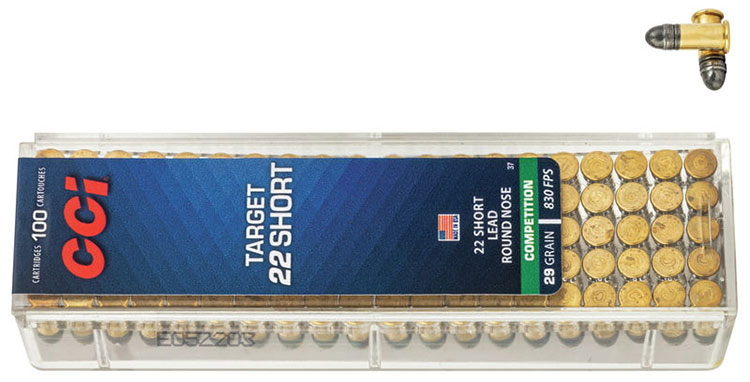
Buy Short Target for USD 15.99 | CCI (cci-ammunition.com)
Test Procedure
The first order of business was to re-zero the Remington/.22 Short combination from 25 to 40-yards, the same distance I used for the airgun test (and also its zero distance).
Next up came trajectory-plotting in increments of 10-yards, starting with a new target set at 100 yards. To increase the odds of capturing loopy Shorts, I affixed a 4 ½” Shoot n’ See bullseye to the upper portion of a white IPSC target. The bull served as the aiming point throughout the test.
To accommodate yardage changes while maintaining a solid bench rest, I mounted the target to a moveable cardboard box. Distances were established by zapping the bench with a laser rangefinder. Shooting was timed to occur between light early-morning breezes.
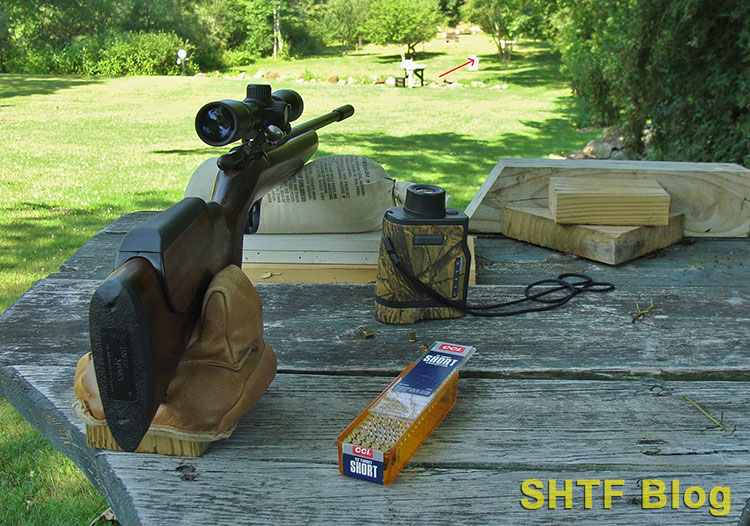
Like the airgun test, I led off with five-shots at 100 yards. Drop was less than expected; 11 ½”. Accuracy, although not stellar, was “okay”, with four of the five shots in 2”. After marking the holes, I moved the target ten yards closer and switched to 3-shot groups. That process continued throughout the remaining yardages, ending at 40 yards. The skimpy 3-shot groups helped minimize confusing overlaps.
.22 Shorts Vs Airgun – Results
As far as trajectory goes, the wimpy standard-velocity .22 Shorts trounced my zippy .22-caliber airgun pellets. The difference became more evident at 70 yards.
| Yards | 40 | 50 | 60 | 70 | 80 | 90 | 100 |
|---|---|---|---|---|---|---|---|
| Traj. (inches) | 0 | -1 | -3 | -6 | -9 | -13 | -17 ½ |
| Yards | 40 | 50 | 60 | 70 | 80 | 90 | 100 |
|---|---|---|---|---|---|---|---|
| Traj. (inches) | 0 | – ½ | -2 ¼ | -4 | -6 | -8 ½ | -11 ½ |
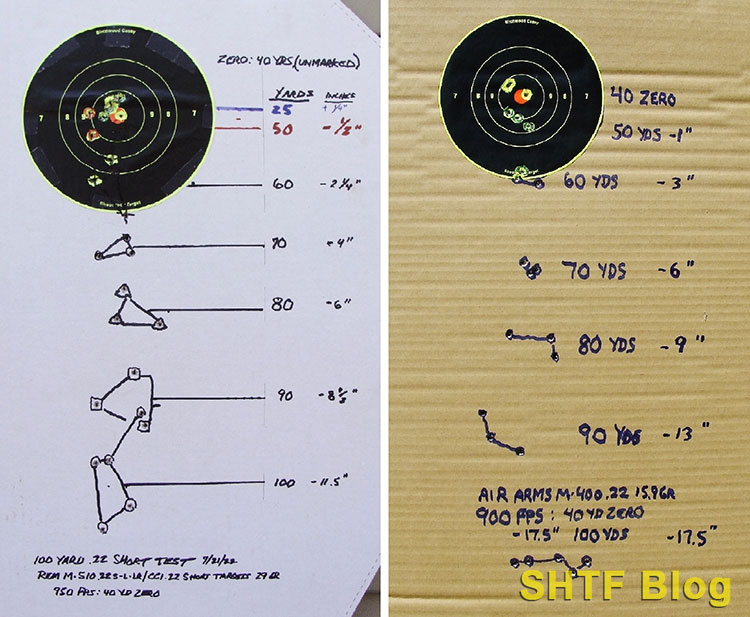
Three additional Shorts fired from 25 yards hit only ¼” above their 40-yard zero – flat enough to cover 50 yards. Actually, in that respect, the airgun wasn’t bad either.
Energy
No contest here: The Shorts clobbered my airgun. No way I could make that up with heavier pellets because their velocities would tank.
The above speeds were established via my chronograph. The resulting foot pounds of muzzle energy (ME) are frequently used to rate airgun “power”. Out of curiosity, I checked the .22 Short data against JBM’s on-line ballistic calculator.
The trajectories were a close enough match to be used interchangeably, meaning their 100-yard velocity and energy figures should be accurate.
https://www.jbmballistics.com/cgi-bin/jbmtraj_simp-5.1.cgi
JSB’s 100-yard .22 Target Short data showed 822 fps, and 43.5 remaining foot pounds: 13 ft. lbs. more than my airgun pellets generated at the muzzle! Sounds impressive, but let’s put it all into context. Most standard velocity .22 LR, 1150 fps, target loads clock around 980 fps at that distance, with 85 ft. lbs. of residual energy.
These figures will change with velocity, but CCI’s .22 Target Shorts hang in there surprisingly well in shorter barrels – to a point. In conventional handguns expect greater loss, and lots of extra noise.
Noise
Despite the Remington’s 24” barrel, the airgun won this round.
That said, although the Shorts were louder than my pre-charged air rifle, the difference was by no means substantial. I’d rate either backyard friendly. For more about these subjects, as well as CCI’s .22 LR “Quiets” and CB Caps, etc., here’s the link:
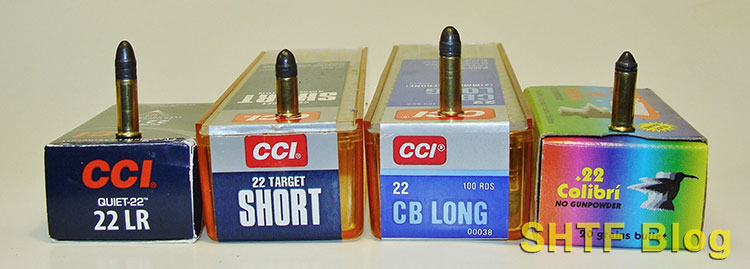
.22 Shorts Ammo – A Rimfire Shooter’s Guide (shtfblog.com)
Accuracy
Major airgun victory here, which came as no surprise.
As noted above, the Air Arms is a tack-driver; no barrel heating, fouling, or hold sensitivities (a concern for many “springer” designs). Rimfire rifles can be fussy and .22 Short accuracy can be a crap shoot beyond 25 yards. During a separate 50-yard test, I had high hopes for my accurate .22 LR Anschutz M-1416 bolt-action, but the Shorts were a flop.
On the other hand, my beater Remington shot acceptably well. But the airgun was in a league of its own. It also posts single-digit velocity variations, whereas Shorts produce much higher spreads (62 fps from the M-510). That factor, and their jump through the .22 LR chamber, may account for occasional fliers (makes me wonder what would happen with a true .22 Short chamber).
Also worth noting, conventional airgun pellets are light enough to wander in wind. Out toward 100 yards, the outcome could reverse.
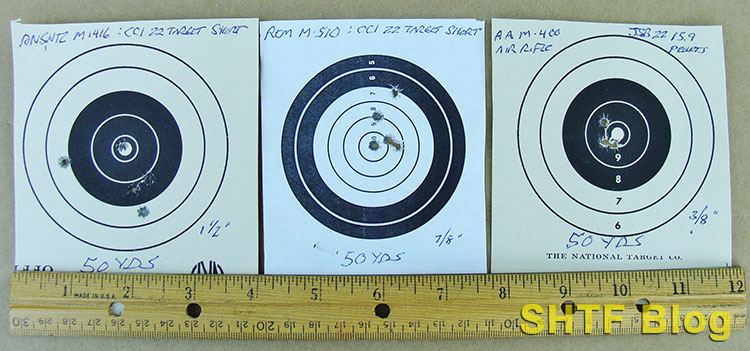
The Fiddly Factor
Could be a tie, depending on the design of the action.
Firing Shorts through the Anschutz required single loading, a “fiddly” process. But at least its chamber is accessible, unlike others, to include Ruger semiauto 10/22s – single-loading PITAs. By comparison, I just dropped ‘em into the feeding tray of my single-shot Remington, which loaded and ejected them without difficulties.
The process was easier than my single-shot air rifle BUT, I also own a repeating PCP Air Arms featuring a removable 10-shot magazine – a breeze once its filled. Then again, same is true of .22 S-L-LR repeating bolt and lever-actions fed from tubular magazines – which typically hold lots of Shorts!
Indoor Residential Shooting
The airgun owns this one.
For safety’s sake you’re better off saving the above .22 loads for outdoor shooting, over concerns regarding lead toxicity and penetration (the 2×6 photo illustrates the latter). Which doesn’t rule out the possibility of creating an affordable indoor airgun range:
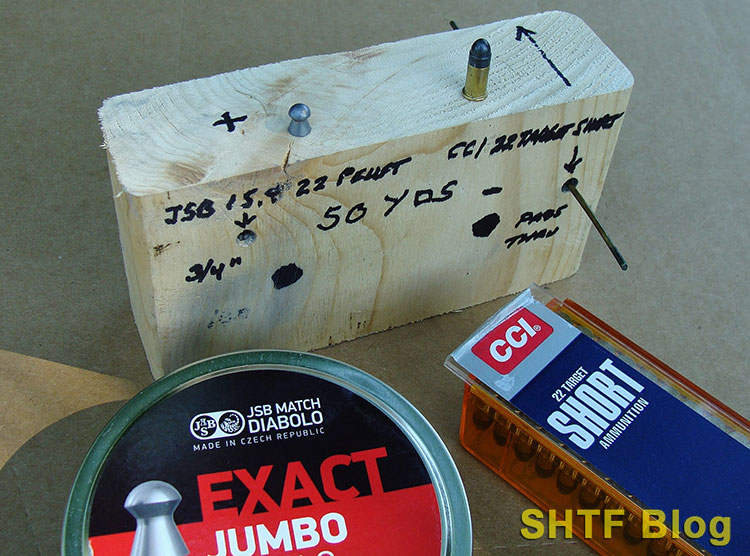
Build a Home Airgun Shooting Range in 10 Steps
Youth Potential
Could be another tie.
Springers can be hard to cock and hold-sensitive, but a charged PCP gun is as easy to shoot as bolt-action .22 rifle. But there are also some ideal youth-sized .22 rifles on the market that permit graduation to .22 LR loads. Using the latter, add a basic scope and you’ll be good to 100 yards with only minor holdovers. But safety-wise, it’s a draw. All require the upmost respect!
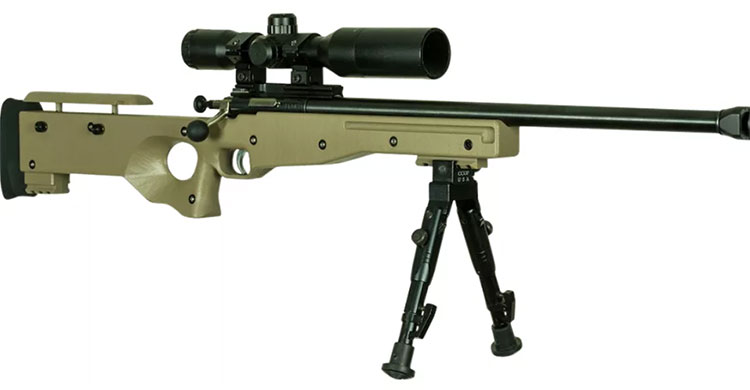
Keystone Sporting Arms Crickett Precision Single-Shot Rifle Package
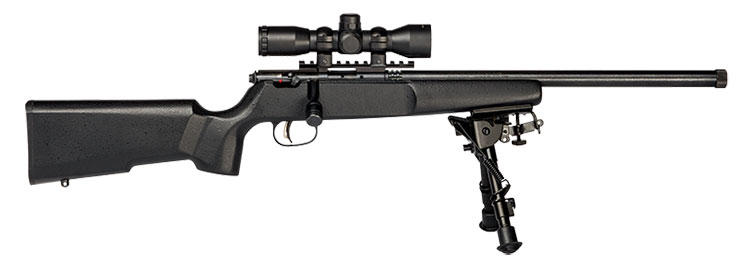
The Winner?
It probably boils down to utility.
Benjamin’s repeating Marauder is popular USA-built PCP rifle. It earns good reviews and sells for around $570 – about half the cost of my British-built Air Arms rifle! But you’ll still need a way to charge it. I use a scuba tank, but the simplest solution is a purpose-built hand pump (like Benjamin’s), which adds $210 extra dollars.
Less costly PCP guns are available, but some operate at higher pressures, making them harder fill. And, at the distances covered above, you’ll want a scope, pushing the total toward a grand. On a positive note, airguns are exempt from federal regulations.
Thus, absent any state or local restrictions, an entire system (to include good pellets), could be shipped directly to your door. You can also shoot them in places where firearms would be off-limits, a big win for some of us!

Benjamin Marauder, Synthetic for Sale
Or, if you already own a suitable .22 firearm, for less than $15, you could try a box of .22 Shorts! With a bit of luck, you may rival the performance of a 30-grain .22-caliber airgun slug. It takes a lot of pressure to drive heavier airgun projectiles of any type without sacrificing velocity – more than most springers and many PCP rifles can produce. Those up to the job are generally expensive – and loud.
So, if firearms restrictions aren’t a concern, the solution could be a lower-powered rimfire load. To stretch the range the solution is a .22 Short. The downsides: top-flight accuracy could be elusive, and a basement range is out. Also, for safety’s sake, you’ll need to brush the resulting annular fouling ring out of the chamber to prevent the possibility of a stuck .22 LR cartridge – a much easier task with a bolt-action.
And if you’re already sighted-in .22 LRs, the switch to .22 Shorts will probably require a different zero (especially when shot at further distances). For more info about rimfires, here’s a link to Rimfire Rifles: A Buyers and Shooter’s Guide:
- Markwith, Steve (Author)
- English (Publication Language)
- 182 Pages - 09/28/2015 (Publication Date) - Prepper Press (Publisher)
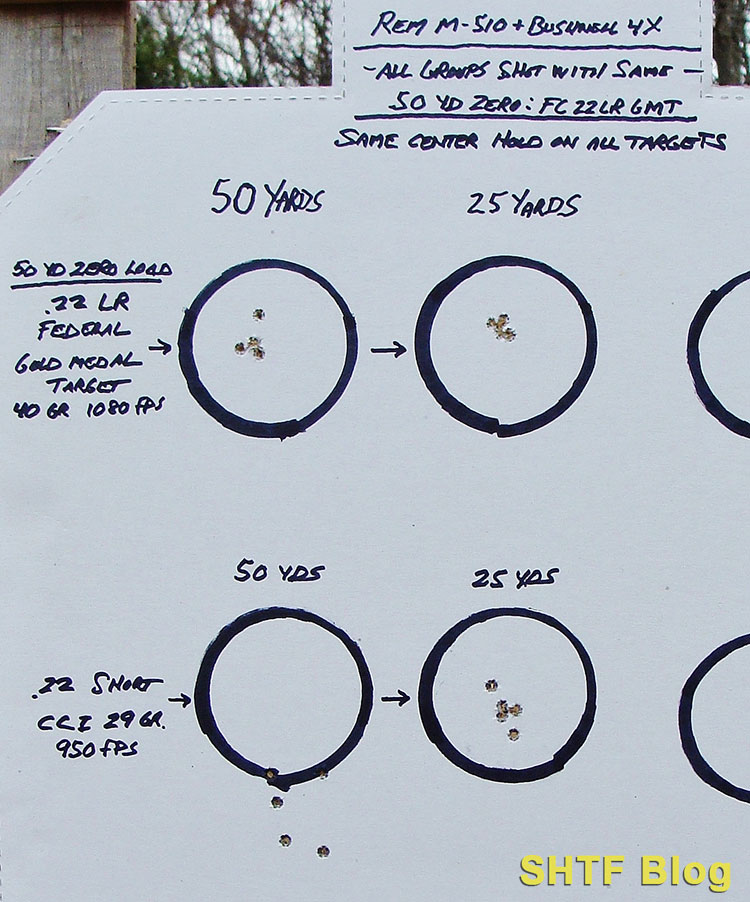
Parting Shots
When using scoped rifles, I zero .22 LR loads at 50 yards. But for either rimfire or airguns in the above velocity ranges, 40 yards could be the more practical sight-in distance- especially for shooters with scopes minus hold-over provisions.
Regarding THE final choice, as far as I’m concerned, both are downright useful for quiet shooting in tighter settings. The bigger hassle with Shorts could be their intermittent availability – the reason I stock up when I can. I wouldn’t be too hung up on brands though.
Several major manufacturers produce at least one version of the .22 Short, and your chamber could easily prefer a different version than mine. The only way to find out is to try ‘em.
Happy shooting!


2 comments
Excellent article
Un PCP calibre 45 o 50 son buenas opciones para caza mayor.